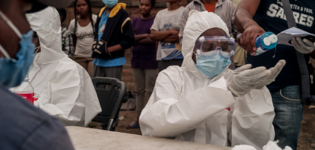Blog
The world needs a people’s vaccine
The world needs a people’s vaccine for COVID-19 — one provided universally, and accessible to the entire world population. A patent-protected vaccine could ultimately exclude many people from being vaccinated and protected. Unfortunately, most projects to develop a COVID-19 vaccine currently underway expect to recoup costs, and profit substantially by exploiting the monopoly granted by globally recognized patents. A patent-protected vaccine will consequently be too expensive to provide for truly universal accessibility. By using alternative research and development frameworks instead, we can develop a COVID-19 vaccine that is compatible with universal access.
Universal access at a low price: making the formula available
In a recent and much more extensive article for the Boston Review, we show that it is possible to create sufficient incentives for vaccine development and provide for low-cost production and distribution. The easiest way to produce large amounts of a medicine and sell it at low cost is to make the formula freely available. That way any manufacturer in the world can produce it and compete with other manufacturers.
The world needs a people’s vaccine for COVID-19 — one provided universally, and accessible to the entire world population.
Historically, the reason this has not been done with all medicines is the unfounded argument that making the formula freely available would necessarily discourage medical innovation. The argument is that without a significant profit incentive, of the kind made possible by patent protection, innovation would not take place.
We note that there are two alternative approaches that can bring about the development of a vaccine. The first, an ‘effort-based’ approach, pays the costs of any organizations that put good-faith efforts towards research and development. The second, an ‘outcome-based’ approach, rewards them for success in meeting specific benchmarks, up to and including a full-fledged vaccine. The effort-based approach enables firms and other institutional actors to participate in research and development without high-powered financial incentives for success. While the outcome-based approach does provide a high-powered incentive, it does not ensure that all who can contribute will be able to do so.
The outcome-based approach works if organized to provide rewards for achieving specific components of a solution. These may be shared among those making demonstrable contributions, with the largest rewards going to those who make the most important contributions or do so first.
The easiest way to produce large amounts of a medicine and sell it at low cost is to make the formula freely available.
Complex research and development projects are often organized this way. For instance, in the defense sector, these approaches have been used to advance robotics and other technologies. For COVID-19, a global initiative of this kind is needed, concentrating the billions of dollars already raised by governments to provide funds to support and reward research and development activities. Any resulting innovations should be made freely available to the public without any of the restrictions on producing and distributing the vaccine that would arise from assigning intellectual property rights. Indeed, any current intellectual property rights that limit the use of inputs employed to develop or produce a vaccine should also be suspended, as a way of accelerating progress toward a vaccine.
Differences from other approaches
The WHO’s COVAX initiative is adopting an Advanced Market Commitment (AMC) — in which an international body agrees to buy a quantity of a vaccine at a negotiated price — as a way of encouraging its development. This scheme does not challenge the presumed right of a vaccine developer to enjoy a temporary monopoly. Rather it sustains the holders of these ‘rights’ with public purchases. Since they participate voluntarily, they must be rewarded sufficiently at a rate greater than or equal to what they would receive if they were to stay out of the scheme. In addition to the higher expense of this initiative, it does not guarantee that a vaccine contracted in this way will be made available at an accessible price.
Summary
A vaccine, such as that for COVID-19, should be priced at the lowest cost possible. This can be best achieved by making the formula for it (or the formulae for them, as there may be more than one) available freely to manufacturers. Bringing a viable vaccine into being does not need to depend on granting monopoly rights. Instead, both public and private organizations engaged in research and development activity should be directly supported, and rewarded, with adequate resources from public sources with a clear understanding that no private monopolies can be claimed from these activities. The resources required to support such a global public research and development effort are sure to be small relative to the enormous benefit of a global people’s vaccine.
It is not too late to change course.
The views expressed in this piece are those of the author(s), and do not necessarily reflect the views of the Institute or the United Nations University, nor the programme/project donors.
 Join the network
Join the network











